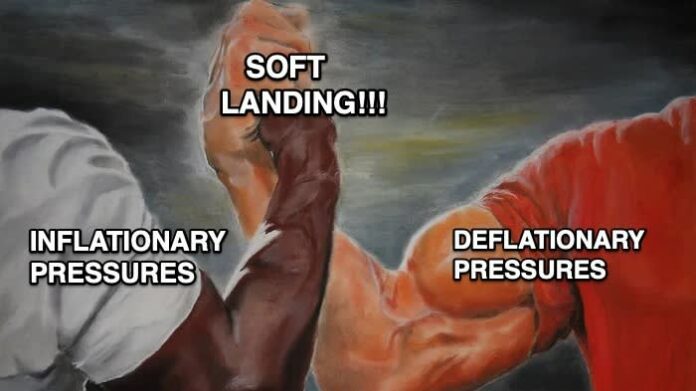Edward Price is principal at Ergo Intelligence. A former British trade official, he also teaches at New York University’s Center for Global Affairs.
It used to be that when indicators were strong, the economy was strong, and markets were strong. And when they were weak, the economy was feeble and markets swooned. The economic world made sense.
Humanity then gulped the apple of quantitative easing (QE). After that, all things reversed. Good news threatened easing, and therefore markets. Bad news secured it, and buoyed markets: they even learned to create bad news (see the taper tantrum of 2013). Who ruled monetary policy? The markets or the Fed? ¯\_ (ツ)_/¯
At least 2022’s aggressive Fed hikes will reassert the natural order, squishing speculation and causing a recession in the US. Right? Only God knows for sure, but his flagship creation, Goldman Sachs, says no.
The US should narrowly avoid recession as core PCE inflation slows from 5% now to 3% in late 2023 with a ½pp rise in the unemployment rate.
Here’s what this looks like in chart format, from Goldman Sachs’s 2023 outlook for the US economy.
This is so deliciously Goldman. It’s just sooo out of step with the herd. And they know it:
So why are Jan Hatzius and his Goldman Sachs colleagues so much more relaxed than the rest of Wall Street? Basically, this time is different:
How can core inflation fall so much with such a small employment hit? The reason, we think, is that this cycle is different from prior high-inflation periods.
There are basically three reasons why Goldman thinks this cycle is so different, and a soft landing is on the cards.
First, the over-hot jobs market has shown up in “unprecedented job openings, which are much less painful [than over-hiring] to unwind.” OK, yes. Just take the job ad down.
Second, as the bank also points out, there’s still more disinflation to come as supply chains and housing markets normalise. Also yes. Look here:
Why? Labour and supply chains/rentals are less inflationary than you think (although Friday’s jobs number looked pretty hot with unemployment steady at 3.7 per cent, and hourly earnings growth is sizzling)
So, Goldman thinks cooler labour + hotter supply = falling core PCE inflation. And so it reckons that the Fed raises rates by another 125 basis points, taking it to a peak of 5-5.25 per cent without cuts, in 2023.
Then there’s the bank’s third reason too: “Long-term inflation expectations remain well-anchored.” Here are some more shapes and colours:
Huge if true. But is it? And, regardless, if the Fed believed it was true, would that belief de-anchor any anchored expectations via any subsequent dovishness?
Let’s not forget John Williams, president of the New York Fed. He thinks unemployment could hit between 4.5% and 5% next year. Plus Kansas City Fed president Esther George: “I don’t know how you continue to bring this level of inflation down without having some real slowing.” Those are major bad cop vibes, even as Jay Powell, the good cop, tells us otherwise.
So, how exactly did GS land on a mere 35 per cent probability of a US recession next year? Simple. There was good news:
. . . incoming activity data are nowhere close to recessionary. The advance GDP report showed 2.6% (annualized) growth in Q3 . . . [and more] fundamentally, there are strong reasons to expect positive growth in coming quarters.
Great. But doesn’t that, like, totally cancel out all the deflationary factors? Surely the Fed could still freak out?
. . . [The] real income upturn is likely to be the stronger force . . . assuming Fed officials do not deliver dramatically more tightening than the rates market is currently pricing.
And there we have it — Goldman is assuming the Fed will not take good economic news as bad inflationary news. Good news is once again good. Never mind the Fed’s credibility snafu over “transitory” inflation means it’s likely to be super hawkish now, and never mind the market’s reaction to Friday’s payrolls data . . .
In an era of inflation, good news may still be bad. There will likely be a recession. But meanwhile, let’s keep asking: who rules monetary policy? The markets or the Fed? Once again: ¯\_ (ツ)_/¯Better answers in the comments below.











